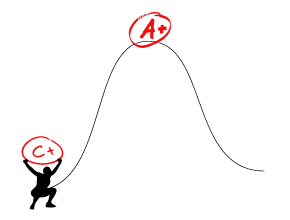
OPINION: Curving Should be Abolished
A curve as a concept depends on the assertion that an individual’s prosperity is tied to the prosperity of their peers. Curves take the difference between the highest score in the class and a 100, and give all of those points to everyone. They artificially increase everyone’s grades without requiring any effort for them. Because curves change the purpose of an assessment from assessing knowledge to assessing relative ability, prevent students from differentiating themselves in their best courses, and seldom are applied equally and fairly to all students, they should be abolished.
Assessments help teachers and students understand what they know and what they still need to know in a course. To a lesser extent, assessments motivate students to really learn the material that is taught; realistically, students would not memorize formulas that will never be used in real life, if they did not need to know them for the test. None of these goals are relativistic or related to the performance of one’s peers.
Curves are, by their nature, relativistic; a curve is determined by the grades of one’s peers. The hated cliche, the infamous maxim told by parents to children “I don’t care how everyone else did, I only care about how you did” does contain a kernel of truth: One’s ignorance is not excused by the ignorance of one’s peers, any more than one’s decision to “jump off a bridge” is excused by the decision of those who jumped first. As hard as it is to hear, the person who makes a 60 on a test only knows 60 percent of the knowledge that is needed. It is irrelevant that the smartest student in the grade made an 80 on the test; ignorance of 20 percent of the knowledge should not be excused.
Curves encourage generalism, being good at everything but great at nothing. Curving makes students feel the need to get a 100 in every class. So, no matter how much they love writing they do not spend a minute thinking about English beyond what will get them 100.
Without curves, only truly exceptional students would get 100s in their best class, so students would be able to specialize in their best subject while maintaining an acceptable class rank. Specialization prevents students from obsessively focusing on their worst subject rather focusing on their best subject, while also providing society with a more useful and productive labor force. In short, everyone wins.
Specialization is the best method of growth; it is what made the West rise. By having people specialize at their own best task, we were able to drastically improve efficiency, which allowed for greater resource production per person, raising our standard of living. Since school is preparation for life, we should imitate this by encouraging students to specialize in what they believe will produce enjoyment, proficiency, and prosperity.
As much as everyone from guidance to the state legislature wants it to be otherwise, not every course is equally challenging. Some teachers make their tests too hard. Some teachers make them too easy. Some teachers never give them, so if students fail one of two high grades for the quarter, they are in trouble. All of these inequalities are exacerbated by curves.
The counter to not curving is that a curve should, ideally, mitigate the effect of teachers from making overly difficult assessments or assessments with untaught material. This is a reasonable concern, but curves are an overly flawed solution to that problem. We should not use curves as a correctional mechanic. Teachers are responsible for designing assessments of appropriate difficulty. Guidance is extremely effective at holding teachers accountable if they do not. Plus, no one wants to be known as an intentionally cruel person, so teachers will act with this in mind.
Excluding all of this, there is already a correctional mechanic built into education. One’s class rank contextualizes one’s GPA. If teachers at a school make their courses overly difficult, then colleges and future employers will realize that when evaluating a potential student’s or employee’s GPA.
No doubt curves are enjoyable. There is pleasure in having relative grade security. However, there are many things that are enjoyable, but bad for us and society. Sodas taste good, but one 16 oz coke has all the recommended sugar for an entire day for a fourteen year old. Curves are the soda of academics. That undeserved 90 on a Gov test tastes so good, yet the pressure to excel in all subjects, even the worst, is not worth it.
Students must ask themselves, “Do I like curves because they prop up my grade or because they’re right?” The sweet taste of curves is not worth the side effects. Accordingly, they should be eliminated.
Writer’s Note: Please leave comments in the section below. I am trying to start a debate—a conversation that will inspire critical thinking. My goal is not to dictate a lesson to the audience, but instead to engage in an academic discussion. Please be kind and critical in your response.